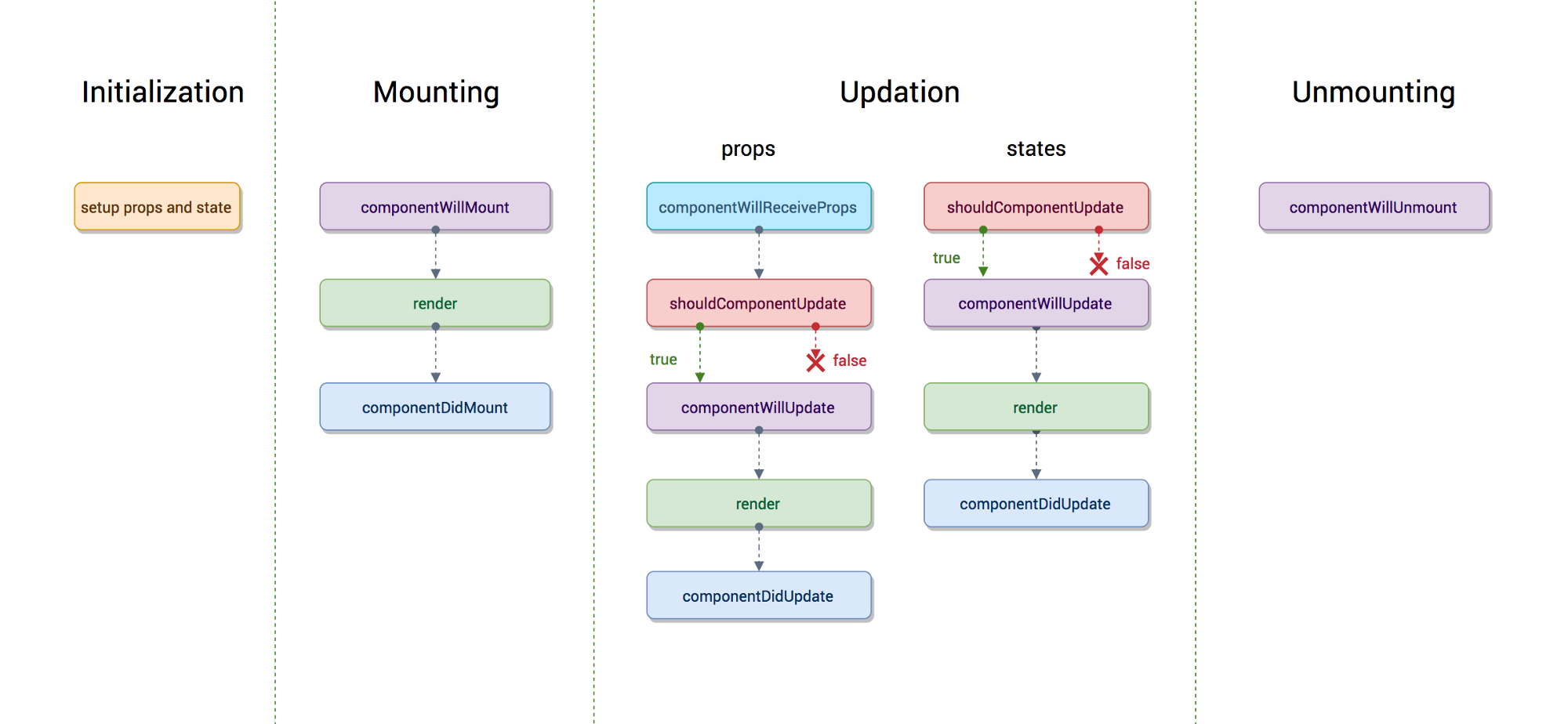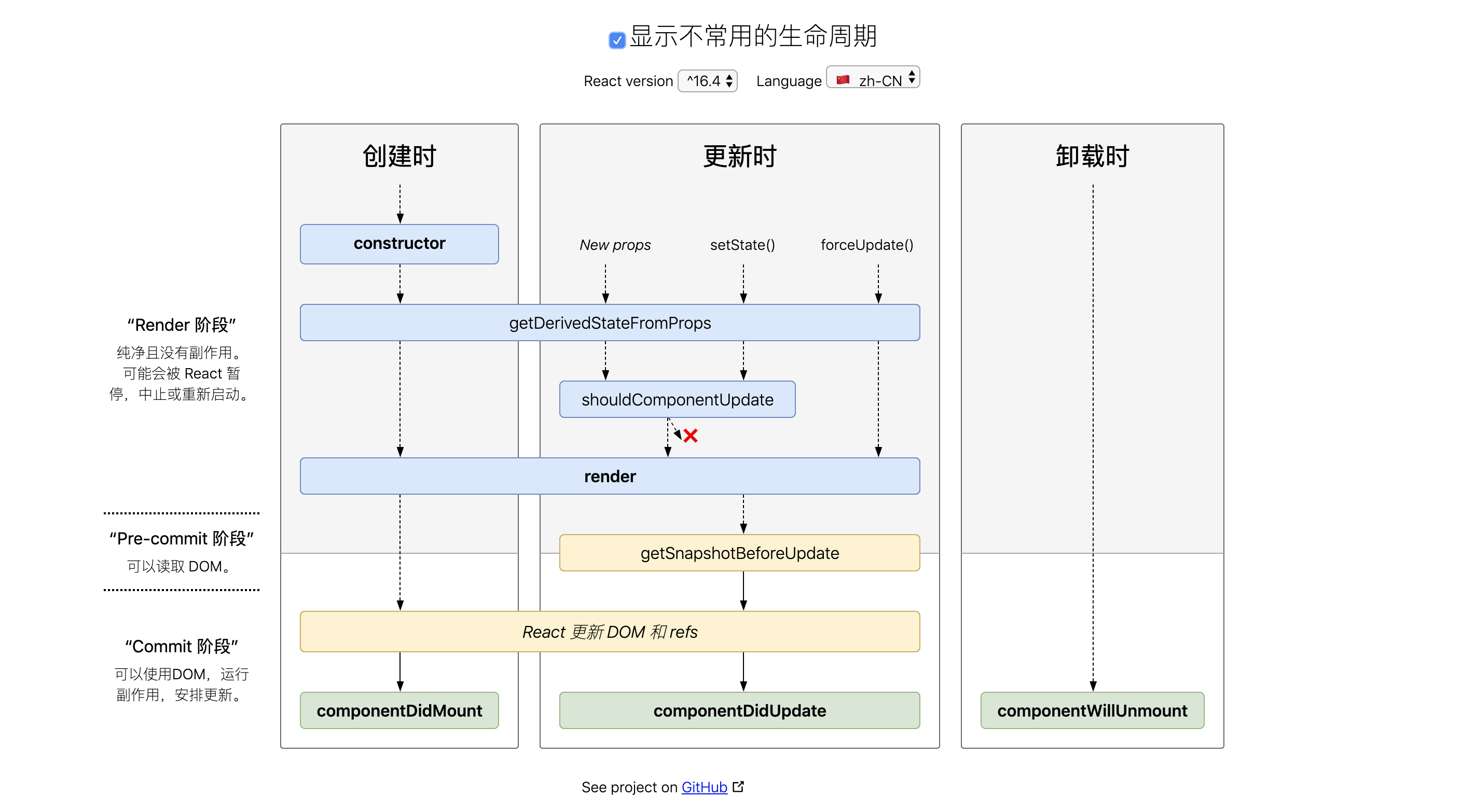react16前的生命周期
在react16的之前生命周期其实主要分为四个阶段:组件初始化、组件挂载、组件更新、组件卸载。
组件初始化阶段
constructor
在该阶段组件中的构造方法 constructor() 接受 props 接收父组件传下来的 props。还可以在 constructor() 内部定义定义this.state 的初始内容。注意:在组件中写了 constructor 方法就必须在里面使用 super(),并且应在其他语句之前前调用 super(props)。否则,this.props 在构造函数中可能会出现未定义的 bug。
constructor(props) {super(props)console.log(this.props) // 在内部可以使用propsthis.state = {//定义state初始值}}
组件挂载阶段
componentWillMount
在组件将要挂载到 DOM 前调用,只会被调用一次,在该方法中修改 state 的值,并不会引起组件重新渲染。(数据请求等异步操作不建议写在该方法内,异步操作可能阻塞 UI)。
componentWillMount(){}
render()
该函数会创建一个虚拟 DOM,用来表示组件的输出。只能通过 this.props 和 this.state 访问数据,且不能在里面执行 this.setState 更该组件状态。在 render 中可以返回 null、false 或者任何 React 组件,只能出现一个顶级组件,不能返回一组元素(在 react16 中有所改善,可以返回一组元素或单个字符串)。
Render(){return (// react组件)}
componentDidMount
组件挂载到 Dom 后调用,且只调用一次。此时组件已经生成对应的 DOM 结构,可以在该函数中通过ReactDOM.findDOMNode()访问到真实的 DOM 或者通过 this.refs.[refName] 属性获取真实 DOM 。(数据请求等异步操作建议写在该方法内)
componentDidMount() {// 进行异步数据请求或者获取dom}
组件更新阶段
componentWillReceiveProps
该函数接受一个参数 nextProps,当父组件重传props时会调用。拿到新的 props 与旧的 props 来比较是否变化,若变化可以通过 this.setState 更新 state。当然也可以不比较新旧 props 值直接更新 state。
componentWillReceiveProps(nextProps) {// 示例if (nextProps.state !== this.props.state) {this.setState({state: nextProps.state});}}
官方提示:在componentWillReceiveProps中调用 this.setState() 将不会引起第二次渲染。
由于每次子组件接收到新的props,都会重新渲染一次,除非你使用 shouldComponentUpdate 来阻止重新渲染,但是你可以 componentWillReceiveProps 中根据新的 props 更新 state,虽然更新state也会触发一次重新渲染,但并不会触发额外的render。
shouldComponentUpdate(nextProps,nextState)
该函数是唯一可以控制组件渲染的生命周期。如果 props 和 state 的改变不需要重新渲染组件。则可以在该函数内返回 false,阻止组件的重新渲染。为了优化组件性能,减少组件的不必要渲染。
shouldComponentUpdate(nextProps, nextState){// return true 更新组件// return false 则不更新组件}
componentWillUpdate(nextProps,nextState)
shouldComponentUpdate 方法返回 true 后,在组件即将进行重新渲染前调用该函数(注意不要里面去更新 props 或者 state,会导致组件进入死循环),在这之后会调用 render 方法进行重新渲染。
componentWillUpdate(nextProps,nextState) {// 不要在此处更新props或state}
componentDidUpdate(prevProps,prevState)
组件被重新渲染后该方法会被调用,可以拿到更新前的 props 和 state 。除了首次渲染时调用的componentDidMount,之后每次渲染都会调用该函数。和 componentDidMount 类似的是可以在这里操作更新后的DOM。
componentDidUpdate(prevProps,prevState) {}
组件卸载阶段
componentWillUnmount
该函数在组件卸载前被调用,可以在执行一些清理工作,比如清除组件中使用的定时器或者事件监听器,以避免引起内存泄漏。
componentWillUnmount() {// 清除定时器或事件监听器}
react16的生命周期
react16的生命周期新引入了三个新的生命周期函数:getDerivedStateFromProps,getSnapshotBeforeUpdate,componentDidCatch,弃用的三个生命周期函数:componentWillMount、componentWillReceiveProps,componentWillUpdate。其他的生命周期功能与前面介绍的相同。
getDerivedStateFromProps(props, state)
该函数在组件挂载阶段和后续更新阶段调用,根据 props 和 state 两个参数,计算出预期的状态改变,返回一个对象表示新的 state进行更新;如果不需要更新,返回 null 即可。该函数用来替代 componentWillReceiveProps。
static getDerivedStateFromProps(props, state) {//根据props和state计算出预期的状态改变,返回结果会被送给setState}
getSnapshotBeforeUpdate(prevProps, prevState)
该函数在render之后被调用,可以读取但无法使用DOM的时候。它使得组件能在发生更改之前从 DOM 中捕获一些信息(例如,滚动位置)。返回值将作为componentDidUpdate的第三个参数。该函数配合componentDidUpdate, 可以替代componentWillUpdate。
getSnapshotBeforeUpdate(prevProps, prevState) {console.log('getSnapshotBeforeUpdate');return 'react16';}componentDidUpdate(prevProps, prevState, snapshot) {console.log('snapshot = ', snapshot);}
static getDerivedStateFromError()
此生命周期会在后代组件抛出错误后被调用。 它将抛出的错误作为参数,并返回一个值以更新 state。
static getDerivedStateFromError(error) {// 更新 state 使下一次渲染可以显降级 UIreturn { hasError: true };}
componentDidCatch(error,info)
任何一处的javascript会触发该函数。
componentDidCatch(error, info) {// 获取到javascript错误}
总结
组件挂载阶段
- constructor
- getDerivedStateFromProps
- render
-
组件更新阶段
getDerivedStateFromProps
- shouldComponentUpdate
- render
- getSnapshotBeforeUpdate
-
组件卸载阶段
componentWillUnmount

参考链接:

